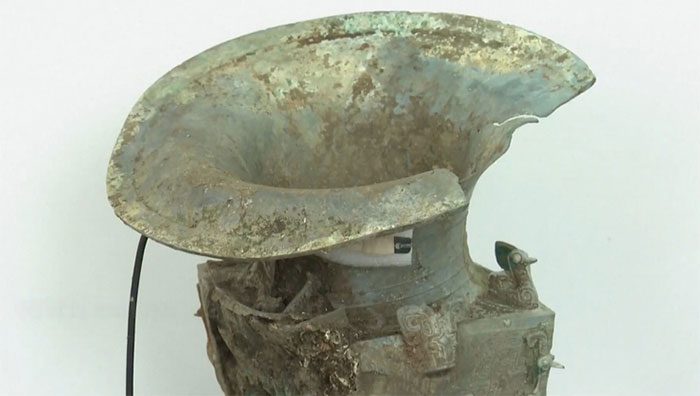In a recent excavation at the Tam Tinh Đôi archaeological site, Chinese archaeologists discovered two famous Zun vessels from the Shu Han period.
Experts from Beijing University of Science and Technology (BUST) are cleaning and examining a rare bronze Zun vessel recently unearthed at the Tam Tinh Đôi site in Sichuan Province, southwest China, hoping to uncover more information about craftsmanship during the Shu Han period (221 – 263 AD). The Zun is a type of ceremonial wine vessel, but this specimen is unique with its round mouth and square body.
The thousands-of-years-old Zun vessel unearthed in China. (Video: CCTV+).
“It stands 45 cm tall and features decorations commonly seen on bronze artifacts from the same period. However, the combination of a round mouth and square body is very rare,” emphasized Professor Chen Kunlong from the Institute of Cultural Heritage and History of Science and Technology at BUST, who leads the research team.
Based on preliminary observations, the archaeologists concluded that the specimen is well-preserved. With several detached parts collected from the excavation site, experts believe it can be fully restored. In addition to restoring the artifact, they will also study the methods and techniques of casting.
“We focus on casting techniques as they reflect the craftsmanship of the artisans. The team will explore how they handled the details and whether there are any technical differences between regions,” Chen added.

The newly discovered Zun vessel at Tam Tinh Đôi.
In addition to the aforementioned specimen, Chen and colleagues also found another large-mouthed Zun vessel at Pit No. 3 of the Tam Tinh Đôi site. Shells were found inside both vessels, leaving archaeologists puzzled about their actual use.
“This large-mouthed Zun is an ancient wine vessel from central China. However, we have no evidence to suggest that the artifacts at Tam Tinh Đôi were ever used to hold wine. Conversely, many shells were found inside, which are often considered a form of currency during the Shang Dynasty (1600 BC – 1046 BC) and the Zhou Dynasty (1105 BC – 1046 BC). Therefore, we can hypothesize that this type of vessel may have been used by the privileged individuals at Tam Tinh Đôi to store their wealth,” said Xu Feihong, head of the excavation team at Pit No. 3 of Tam Tinh Đôi.
The Tam Tinh Đôi site is located in Guanghan City, approximately 38 km from Chengdu, the capital of Sichuan Province. It was discovered in 1986 and is believed to be the remnants of the Shu Han Dynasty. Currently, an excavation involving over 30 organizations is underway in six newly discovered pits at Tam Tinh Đôi.





















































